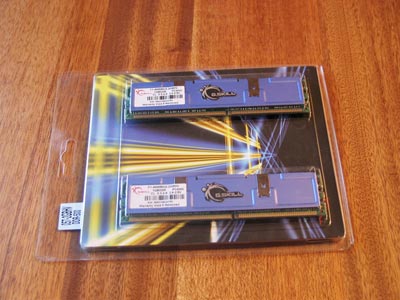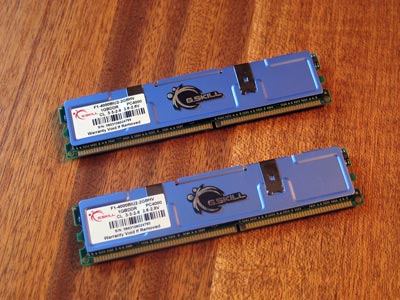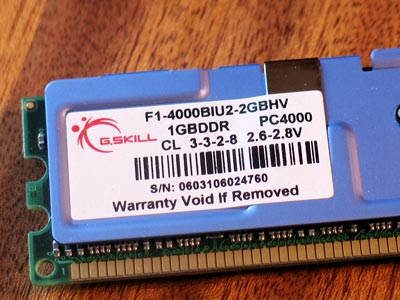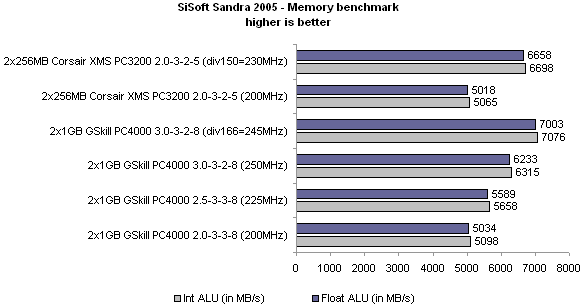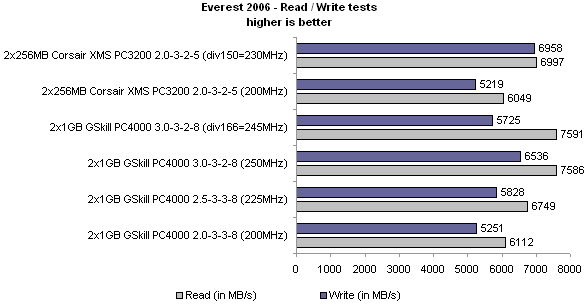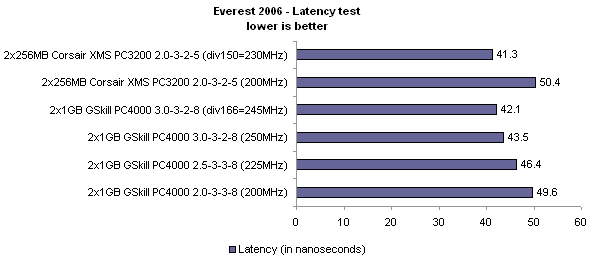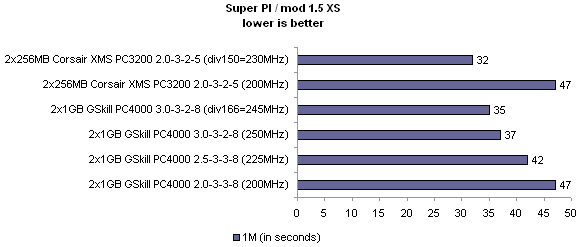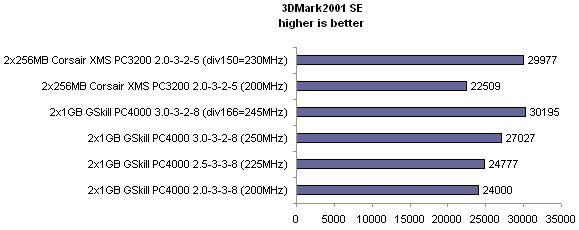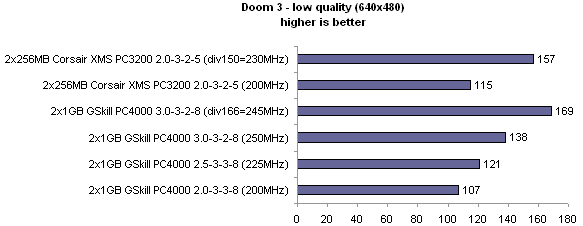The G.Skill F1-4000BIU2-2GBHV is aimed at enthusiasts and gamers. It’s a great memory for ~270 green. It can run at tight CL2 timings and looser timings at CL2.5 and CL3 without having to raise the VDIMM (2.6V default). This is great especially for those who cannot change the voltages. The G.Skill kit can do from 200 to around 255 MHz stable at various timings.
Introduction
Memory requirements are slowly building up to a point where 512 MBs or even 1 GB is no longer eough. Memory hugging applications and high system requirements for games are a tip of the iceberg. More interesting, various IT websites and magazines are talking about Vista utilizing as much as 2 GBs of system memory on 64-bit CPUs and at least 1 GB of RAM for 32-bit processors. Even today in the era of Windows XP we are seeing game titles needing as much as 2 GBs of system memory to comepletely satisfy the requirements.
A few months back we’ve reviewed a 2 GB kit from Corsair, TWINX2048-4400PRO. Those sticks were running at a rather crazy speeds for 1 GB modules: PC4400 (DDR 550 MHz). Usually high density modules are set to run slower and with higher timings than let’s say 512 MB parts. For high speed 1 GB chips CAS 3.0 is usually a standard. Needless to say the demand for a lot of RAM is increasing and has grown to a point where companies started to sell those to regular customers, especially enthusiasts. Ten years ago I would have not imagined 2 GBs of memory in my system. Even today 1 GB is surely enough to run any application, but of course everyone is going with the trend of having the best performing components.
Today I will be looking at a 2 GB kit, this time from a known enthusiast company G.Skill
“G. SKILL”, established in 1989 by enthusiasts, is a leading memory Module Manufacturer based in Taipei, Taiwan.
With traditional strengths, we have built excellent reputation by meeting market demand and fostering business competitiveness both locally and internationally with our dedications to:
– Competitive prices
– On-Time Delivery
– Assured Quality
– Customer-Oriented Services
– Various Products
As far as G.Skill product line is concerned, it’s very dense and everyone should be able to find something for themselves. What I’m testing today is a kit that has been introduced circa 3 weeks ago: G.Skill F1-4000BIU2-2GBHV PC4000 3-3-2-8. This is a dual channel 2×1024 MB pack designed to give you highest performance for at a reasonable price.
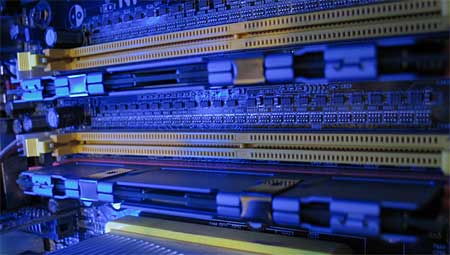
Specifications
Here are the important specifications taken from G.Skill’s website:
- Package: 2048MB kit (2x1GB) dual channel pack
- CAS Latency: 3-3-2-8 (PC4000)
- Test Voltage: 2.6~2.8 V
- PCB Board: 6 Layers PCB
- Speed: DDR 500MHV (PC4000)
- Type: 184-pin DDR SDRAM
- Error Checking: Non-ECC
- Registered/Unbuffered: Unbuffered
- Quality Control: Comprehensive rigorously tested in pair at dual channel environment
- Warranty: Lifetime
G.Skill recommends DFI, MSI or Epox Socket 939 nForce4 motherboards for this RAM.Closer Look
Unfortunately, we will not be looking at the memory ICs as I do not want to damage the chips — and believe me, G.Skill makes sure those modules are properly protected with heatspreaders. Underneath, you will find a tape across all ICs. It’s rather hard to pull it apart, and again, I do not recommend doing it. One, you will lose warranty; secondly, it’s possible you can damage your RAM. I will reveal what chips are under the blue aluminum in a minute.
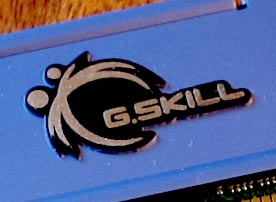
Click a picture to see a larger view
Click a picture to see a larger view
Click a picture to see a larger view

As most memory manufacturers, G.Skill uses a top of the line Brain-Power PCB.
Test Bed
As far as the testing bed goes, I’m using my standard benching machine, but this time I’ve upgraded to the latest BIOS for my DFI motherboard.
| Components | – DFI NF4 Ultra-D (latest official BIOS) – Athlon64 3000+ Venice – 2x1024MB G.Skill F1-4000BIU2-2GBHV (dual channel) – 2x256MB Corsair PC3200LL (dual channel) – Thermaltake ToughPower 550 Watt PSU – PowerColor X1900 XTX 512 MB |
| Software | – Windows XP SP2 – DirectX 9.0c – nForce4 6.53 drivers – CATALYST 6.3 |
| Benchmarks | – SiSoft Sandra 2005.SR3 memory benchmarks – Everest memory benchmarks – Super PI calculator (1 million) – 3DMark2001 SE – Doom 3 / default timedemo – Quake 4 / custom timedemo |
| Notes | – CPU speeds from 1.8 to 2.75 GHz (static 9x multiplier) – Various memory frequency |
As you can see, I’m not using the same CPU clock for all tests, instead I’m just changing the HTT clock. Might not be the best solution, but my CPU’s highest multiplier is 9, and it’s hard to get similar clocks even with DFI memory dividers.Performance – Synthetic
Here, I will be testing the memory’s actual throughput using various applications. The first section takes care of synthetic testing at different speeds. Timings were kept at factory default except for CL2 and CL2.5; Corsair results contain overclocked modules running at 230 MHz (DDR460).
9×200-2-3-3-8
9×225-2.5-3-3-8
9×250-3-3-2-8 + SP2004
9×305-3-3-2-8 + SP2004
Performance – Gaming
Leaving synthetic testing behind, let’s look at gaming performance. At the bottom of the page, I’ve included some interesting results from Quake 4. Output should be self explanatory; however, ultra quality testing gave me a little odd performance. I would have thought 2 GB of RAM would play a more important role in supplying juice for 1600×1200 resolution and 4xAA / 8xAF mode.
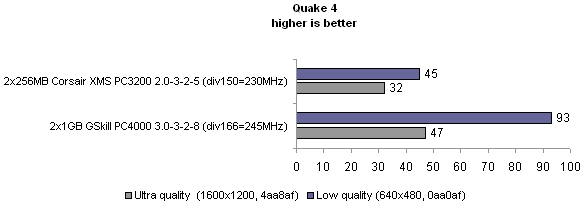
When I say overclocking, I’m talking about clocking a component beyond the specs. Since the F1-4000BIU2-2GBHV is rated at PC4000, its speed is 250 MHz (DDR500). I would have thought those Infineon CE-5 ICs would yield higher overclock rates, but instead I’m getting lockups at 260 MHz when trying to run 3DMark or any other 3D application. Interesting enough in 2D mode, SP2004 (RAM+CPU burn in program) does not produce any errors. At 270 MHz, I was faced with artifacts and raising VDIMM did not help at all.
Conclusions
The need for 2 GB of RAM is coming soon with the introduction of Microsoft Vista which is said to use as much as that. The G.Skill F1-4000BIU2-2GBHV is aimed at enthusiasts and gamers. It’s a great memory for about $270. It can run at tight CL2 timings and looser timings at CL2.5 and CL3 without having to raise the VDIMM (2.6V default). This is great especially for those who cannot change the voltages. The G.Skill kit can do from 200 to around 255 MHz stable at various timings. If you want to buy RAM to go past 250 MHz mark, this kit is not for you as you will experience issues in 3D applications. If you want it straight for running at DDR500 and 3.0-3-2-8, it’s one of the best money can buy.
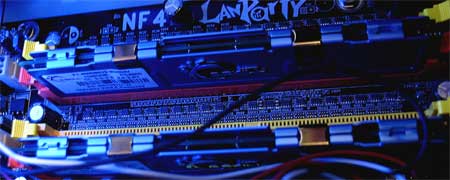
G.Skill F1-4000BIU2-2GBHV in its glory
+ Rock solid @ DDR500, 2.6V
+ Able to run CL2, CL2.5 @ lower timings
+ VDIMM from 2.6-2.8V
+ Nice heatspreaders
Cons:
– Doesn’t run stable in 3D past 250 MHz
– Increase in VDIMM does not yield more MHz
For rock solid performance and tight timings, G.Skill F1-4000BIU2-2GBHV gets the rating of 9 (Extremely Good) out of 10 and Bjorn3D Seal of Approval Award

 Bjorn3D.com Bjorn3d.com – Satisfying Your Daily Tech Cravings Since 1996
Bjorn3D.com Bjorn3d.com – Satisfying Your Daily Tech Cravings Since 1996
